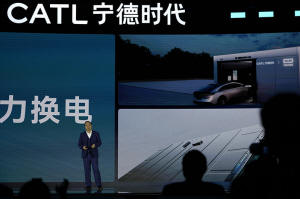China's getting a big electric car battery swapping boost in 2025. Would
that work across the globe?
 Send a link to a friend
Send a link to a friend
 [December 19, 2024] By
ALEXA ST. JOHN [December 19, 2024] By
ALEXA ST. JOHN
Detroit (AP) — China will soon see a massive expansion of electric
vehicle battery swapping, as global battery maker CATL said Wednesday it
is investing heavily in stations there next year.
Battery swapping is not new — but it's had a challenging journey.
Adoption of electric vehicles has varied in regions across the globe
over the past several years, and that doesn't always bode well for
building new infrastructure.
While the technology could do well in China, it's uncertain whether it
could work in other countries.
What is battery swapping?
Battery swapping allows EV drivers to pull into a station on a low
battery and receive a swapped, fully-charged battery within minutes.
An EV has to be equipped with the right technology to receive a swap —
and not many models around the world currently have it. Automakers have
to buy into the idea, and EV adoption among consumers also has to grow,
so that investing in new infrastructure seems worthwhile. Consumers also
have to be comfortable not owning their battery.
Why could it work in China?
China is much further along in adopting EVs than other countries.

Not only is it the world's largest auto market, but in July, the country
hit a milestone with 50% of new sales electric — and it accounts for
most of this year's global EV sales.
China supports EV growth through government subsidies and mandates. So
it makes more sense for companies to invest in unique EV infrastructure
there because that's more likely to be needed.
What other attempts at battery swapping have occurred?
The most notable example might be Israeli startup Better Place, which
tried its hand at swapping in 2007.
But the company shut down a few years later after investing a lot of
money and coming up against roadblocks with logistics. EV adoption was
especially low at the time.
Could it work in the United States? Europe?
Startup Ample, for example, has a modular battery swapping station that
it says can complete a swap in 5 minutes. That’s important as charging
time remains a point of concern for prospective EV buyers. Even the
fastest fast chargers could take at least 15 minutes for a decent
charge.
[to top of second column] |

Robin Zeng, the CEO of China-based CATL, the world's largest maker
of batteries for electric vehicles, speaks at a launch event for the
next generation of swap stations held in Xiamen in southern China's
Fujian province on Wednesday, Dec. 18, 2024. (AP Photo/Ng Han Guan)
 But in the U.S., pure EVs only
accounted for 8% of new vehicle sales as of November.
Meanwhile Nio, a rival Chinese EV brand, has about 60 swap stations
in northern Europe, and the EV adoption is higher there than the
U.S., but the same challenges remain.
Different automakers put different batteries in their various EV
models, so a station would need all of those available if the
industry didn't agree to a standardized battery, and not all of
those models are out yet in volume. This is something that really
needs scale.
Swapping could help with EV cost — currently a barrier to adoption
for many — because a driver wouldn’t necessarily own the most
expensive part of an EV: the battery.
Greg Less, director of the University of Michigan Battery Lab, said
with proper framing and education, people might like the idea of
battery swapping. To him, it's not unlike buying a propane-fueled
grill and purchasing a refilled tank every so often. But it would
require a rethinking of car ownership.
"Where I could see it working is if we went entirely away from
vehicle ownership and we went to a use-on-demand model," Less added.
“I don’t think we’re there yet.”
What vehicle uses might be best for swapping?
Battery swapping might make most sense for ride-sharing or other
fleet vehicles.
Drivers of buses, taxis, Uber or Lyft vehicles want to spend as much
time on the road as possible, transporting customers and making
money. If battery swapping can shorten the time needed to charge EVs,
that makes driving one less disruptive to their business.
All contents © copyright 2024 Associated Press. All rights reserved
 |